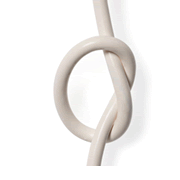Permanent birth control: So many ways to tie a tube
Done having kids, or 100% sure you don't want any? Might want to look into sterilization.

If you’ve made the decision that having kids isn’t for you, or if you’ve had your fill of reproducing, sterilization is an important option to talk about with your health care provider.
Nearly a third of American women who use contraception rely on sterilization for contraception. Sterilization works by preventing an egg from meeting up with sperm. These days, there are lots of ways to have your “tubes tied.” All the techniques doctors use are highly effective, safe, and non-hormonal, so your cycles don’t change. All the techniques are permanent, though, and can’t be reversed—so it’s important to be absolutely sure that this is the right decision and time for you.
Here are some of the things you’ll want to consider.
Surgery Versus Non-Surgical Sterilization
Surgical Sterilization. For surgical sterilization, a doctor makes an incision in the skin of the belly. Your doctor doesn’t really tie your tubes into a neat little bow during the surgery, but can put a clip, band or ring on them, or remove a section. Surgical sterilization goes by different names, depending on the technique the doctor uses—laparoscopy and mini-laparotomy are the most common. For laparoscopy, the doctor usually makes two incisions that are less than half an inch long and uses a tiny camera to help locate and seal the tubes. For a mini-laparotomy, the doctor makes an incision just above the pubic hair and moves the tubes toward the incision to seal them. All surgical sterilization techniques are effective immediately.
Non-Surgical Sterilization. Essure is a less invasive sterilization technique also called a “transcervical procedure.” You don’t have any incisions and the tubes are blocked by your doctor placing something inside them from the vagina. It’s like a longer, more involved pelvic exam, usually with a local anesthetic. The doctor threads a small tube through the cervix, into the uterus, to the spot where the Fallopian tubes start. The doctor places a small metal wire inside the Fallopian tube. Scar tissue grows around the wire and blocks off the Fallopian tube. The scar tissue doesn’t form immediately, so these procedures take a few months to become effective. You should use a back-up method for three months after the procedure, then return to the doctor to make sure the tubes are blocked using an x-ray or an MRI. About 95% of women have blocked tubes after three months, so it’s important to make sure you’re not among the other 5% before you stop using your back-up method.
Essure will no longer be sold after the end of 2018. Find out more here.
When to Have the Procedure
You can have any of these forms of sterilization done at almost any time, as quick outpatient procedures with no hospital stay. It’s also common to plan for sterilization immediately following giving birth. If you have a caesarean delivery, or C-section, it’s easy for the doctor to do a laparotomy then. If you have a vaginal birth, it’s common to wait until the next day. If you opt for a transcervical procedure, it can be done any time when you’re not pregnant except for immediately following a birth.
Paperwork: Waiting Periods and Informed Consent
Most public and private health insurance covers tubal ligation, but they may not cover all types of procedures. You can call your insurance provider or doctor’s office to learn more. Keep in mind that most insurance companies require you to have signed paperwork up to 30 days before the procedure.
All doctors will require you to read and sign an informed consent that says you’re really, really sure this is the right choice for you. I said it before, but I will say it again: sterilization is permanent! The tubes can’t just be “untied” if you change your mind and want a(nother) pregnancy. If you want an effective option that is long-acting, but reversible, think about an intrauterine device (aka IUD), not sterilization.
If you’re younger than 30 or have no kids, your doctor may not agree to do a sterilization procedure for you. If you’re sure sterilization is right for you, stick to your guns! There are doctors who will help if you can explain why it’s what you want.
And the Easiest Form of Sterilization Is…
These female sterilization methods are all great options, but my favorite method of sterilization? The vasectomy. It is by far the easiest, safest method of sterilization. So if you’re in a committed relationship, talk to your partner about getting his tubes tied! Getting his snipped takes about five minutes and can be done in a doctor’s office. While it does take a while for him to run through any sperm he’s stored up, the vasectomy is another great option for couples to consider.
How do you feel about this article?

Heat up your weekends with our best sex tips and so much more.
